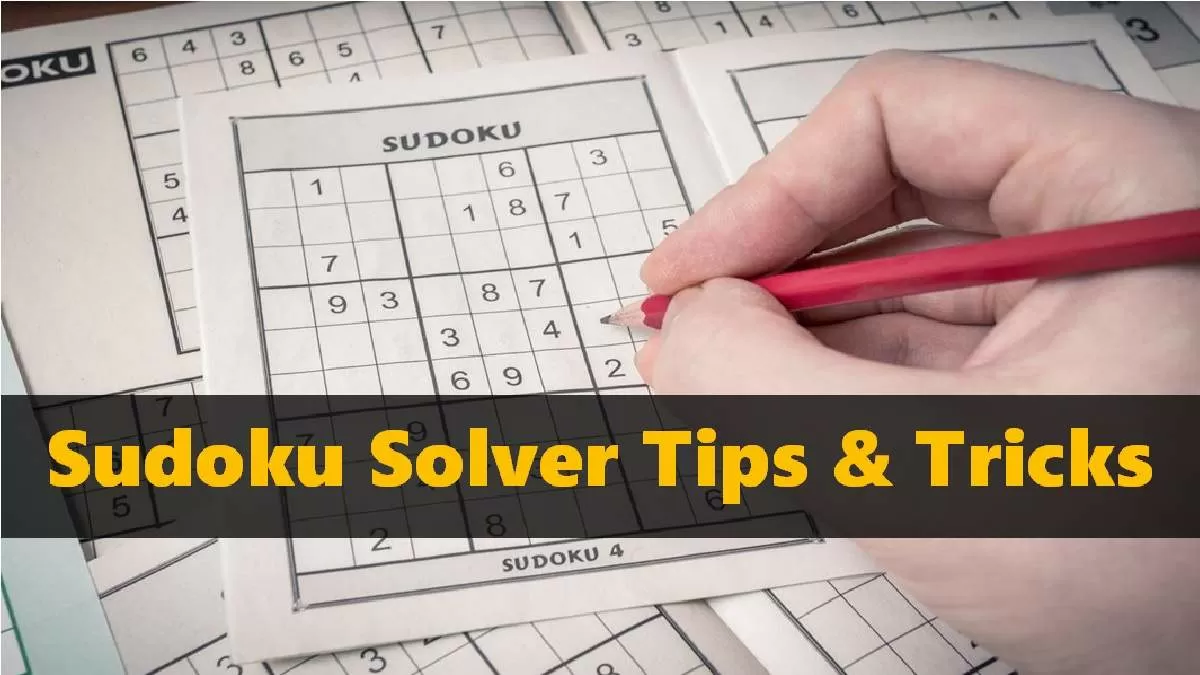Sudoku Solver Tips: One of the most popular brain puzzle games in the world is Suduko which is both challenging and rewarding. We all must have seen the printed version of Sudoku in newspapers and magazines.
Sudoku was published by French newspapers under the name Number Place. It gained popularity in 1986 after being published by the Japanese puzzle company Nikoli under the name Sudoku meaning Single Number. In 2004, Sudoku was featured in The Times (London).
What is Sudoku?
Sudoku is a logic-based, combinatorial number-placement puzzle. In classic Sudoku, the objective is to fill a 9×9 grid with digits so that each row, each column, and each of the nine 3×3 subgrids that compose the grid (also called "boxes", "blocks", or "regions") contain all of the digits from 1 to 9.
The difficulty level of a Sudoku puzzle can be easy, medium, hard, or very hard. The easier the puzzle, the more the numbers pre-filled in the grids. The harder the puzzle, the fewer numbers pre-filled in the grids.
Sudoku is a game of logic and reasoning, and it requires you to think carefully about the placement of each number. There is no need for any calculation or mathematical operations, but you do need to be able to see patterns and make deductions. Sudoku is a great way to improve your brainpower. It can help to improve your memory, concentration, and problem-solving skills. It can also be a lot of fun, and it is a great way to relax and de-stress.
How to Play Sudoku?The objective of Sudoku is to fill in the missing numbers in a 9x9 grid so that each row, column, and 3x3 section boxes contain all digits between 1 to 9 without repetition. One needs to apply logic and keep a few rules in mind: (i) No row can contain more than one of the same number from 1 to 9 (ii) No column can contain more than one of the same number from 1 to 9 (iii) No 3x3 grid can contain more than one of the same number from 1 to 9 Tips & Tricks for Beginners1. Scanning Rows and Columns Start by scanning rows and columns. Look for rows and columns with a lot of numbers already filled. For example, rows with almost 5 out of 9 numbers or a 3x3 grid with 6 out of 9 numbers pre-filled are a good place to start. This helps you in spotting which numbers are missing easily and quickly. Filling in these numbers will give you the boost and cue to find the missing numbers across corresponding rows, columns, and grids. 2. Sudoku Pencil Marking Another systematic Sudoku solver strategy is pencil marking which means you pencil in possible numbers inside cells after scanning rows, columns, and grids. This helps you in identifying combinations and later erase numbers that do not fit the solution. Always use a pencil to solve Sudoku. 3. Check Single Candidate In cases where 8 out of 9 numbers have been used in the surrounding rows, columns, and grids, one needs to take a careful look and figure out the only number missing. Suppose, 4 numbers are already filled in a 3x3 grid while two numbers have been used in the same row and two numbers have been used in the same column. This gives us a cue in figuring that only one candidate (digit) is the right and remaining solution. 4. Elimination Method The elimination process is another logical strategy to solve Sudoku where you analyze the rows, columns, and grids and figure out the remaining candidates by eliminating the possibilities of numbers as they might be already filled in or not a possibility due to their placement in the surrounding rows, columns, and grids. |
Let us Solve a Sudoku
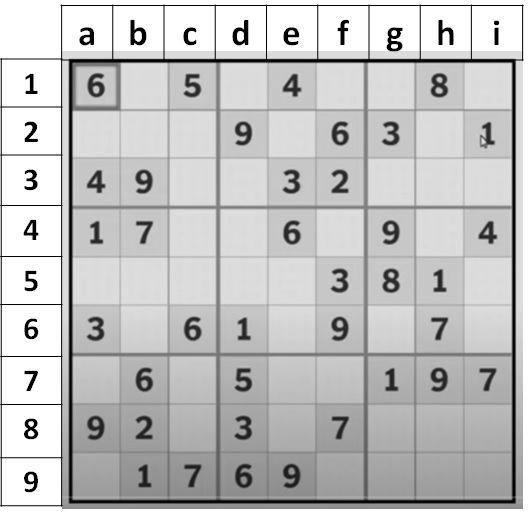
We shall solve the a1 to i1, a2 to i2, and a3 to i3 rows, columns, and grids to explain how to solve a Sudoku puzzle.
- We begin with the a1 to i3 grids. After scanning through the rows and columns, we have a 1 in i2 and a 2 in f3. So, we will hold on and move ahead. We now see that g2 has a 3, and e3 has a 3, hence we figure that c3, c2, b2, and a2 cannot have a 3. Hence, we put 3 in the b1 cell.
- Moving on, we notice that a3 has a 4 and 31 has a 4. Hence, g1, i1, g3, h3, i3 cannot have a 4. Hence, we put a 4 in the h2 cell.
- Moving on, we notice that we have a 5 in c1 cell. However, we do not see another of it. So we carry on. Next, we see a 6 in a1 and another 6 in the f2 cell. So, using logic as previously, we figure that g1, i1, and h2 cannot have a 6 in them. So the possibility of a 6 remains in the g3, h3, and i3 cells. However, we do not have a 6 in the surrounding columns, hence we keep it as a possibility and move on.
- Next, we have only an 8 in h1 cell. Moving on, we have a 9 in b3 and another 9 in d2. Hence, we play on this. This gives us the cue that a 9 cannot be placed in g3, h3, i3, and h2 cells. We are left with the possibility of a 9 either in g1 or i1 cells. Looking further column-wise, we see a 9 in g4 and h7 cells. Hence, we further know that a 9 cannot be placed in the g1 cell. Hence, we shall put 9 in the i1 cell.
So far, our Sudoku looks like this:
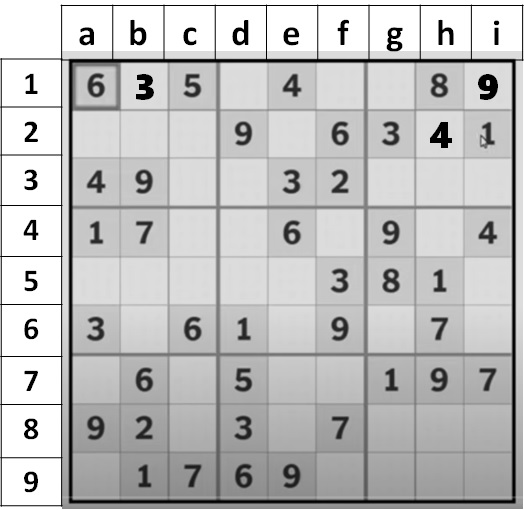
- Moving on, we go over the number 1 to 9 again. We see now that there is a 2 in f3 cell. Now, we scan the rows and columns again and see that the possibility of another 2 can be in the a2, b2, c2 cells as there is already a 2 in the 3x3 grid of d to f cells and g2, h2, i2 cells are filled.
- Hence, after scanning across, we see there is a 2 in the b8 cell, hence we rule that a 2 can be placed either in a2 or c2 cells only. Moving further, we figure there is 1 in i2. After further scanning, we spot a 1 in a4 and d6 cells. Hence, we have eliminated a1, d3, and e2 cells for putting a 1. We shall put the 1 in the f1 cell.
- Next, we notice there is a 5 in c1 cell hence d1, f1, g1 cannot have a 5. After elimination, we are left with e2 so we put a 5 in the e2 cell and keep a possibility of a 5 in g3, h3, and i3 cells.
Now, our Sudoku looks like this:
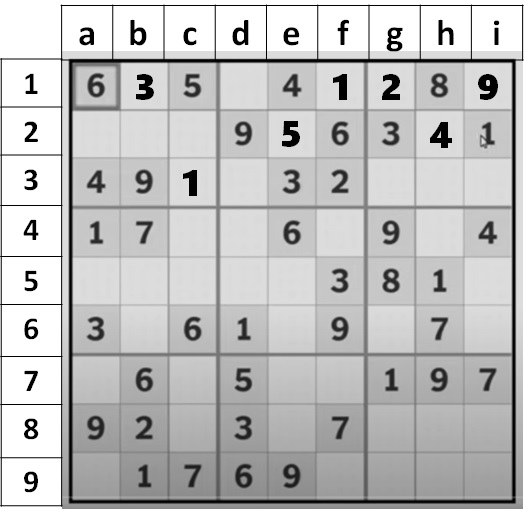
- In cells a1 to i1, we only have one candidate missing in d1 which is a 7. Now further, a 7 will go in the g3 cell as upon looking we see a 7 in h6 and i7 cells. Moving on, we figure that an 8 cannot go in g3 as there is an 8 in h1 cell while a3, b3, c3 cells are already filled. Hence, we put an 8 in the d3 cell.
- Now, we have already figured that a 7 is in d1 and a 7 in g3 so we can find the remaining 7. Upon scanning, we see that there is a 7 in b4 and another 7 in c9 cell. Hence, with the elimination method, we can put the remaining 7 in a2 cell.
- Now back to the remaining 2, we see there is a 2 in the b8 cell hence we are left with the c2 cell. We put a 2 in the c2 cell. Now we can fill the remaining single candidate in the b2 cell which is an 8. Now, we are left with h3 and i3 cells. These two cells can be figured only after solving the remaining rows, columns, and grids.
We shall share the solved Sudoku puzzle here for you to learn and practice.
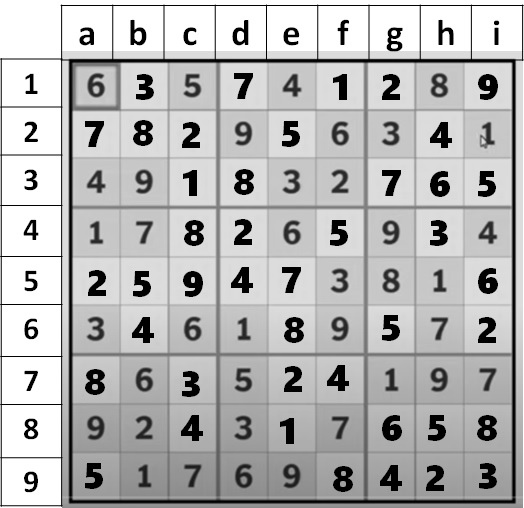
Check out more puzzles to test your IQ
Also check: You Are Full Power Observant If You Can Spot The Tiger Within 6 Seconds!
Also check: Optical Illusion Challenge: Only Eagled Eyes Can Spot The Second Eagle Within 6 Seconds!
Also check: Optical Illusion Challenge: Only 1% With Sharp Vision Can Spot The Second Horse Within 6 Seconds!
Also check: Which Tank Will Fill First? Answer In 5 Seconds, 98% Fail This Test!
